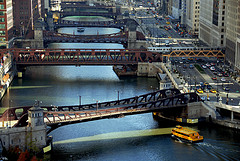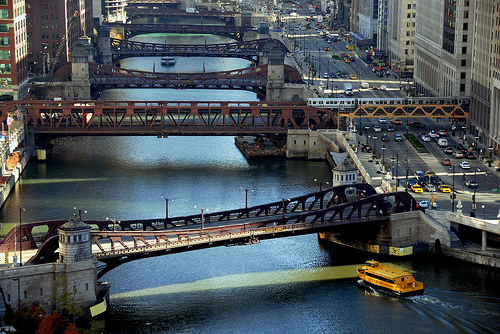
Last summer I visited Chicago, Illinois with my family. The city is very nice (if you like cities) and I was impressed by the beautiful beaches due to the bordering Lake Michigan. From far too many tours I learned that Lake Michigan is where the city and much of the area obtains its drinking water, and is vital economically to the entire region. I also learned that the Lake was once much more polluted. At the turn of the century, Chicago’s sewers flowed directly into the Chicago River which unfortunately empties into Lake Michigan. When people became sick from the untreated sewage contaminating their drinking water, the Sanitary District of Chicago accomplished an unprecedented feat – they reversed the flow of the Chicago River. It now flows toward the Mississippi River basin. Of course this only prolonged dealing with the problem as the river is still considerably contaminated.
And now, due to drought, Lake Michigan faces the Chicago River’s threat once again. Due to drought, water levels on Lake Michigan are the lowest in recorded history. If this trend continues, the Chicago River could resume is intended course and send sewage back into the Lake. According to Henry Henderson of the Natural Resources Defense Council, “[The Chicago River] depends upon gravity to go away from us. If that gravity does not work with the lake going down, it goes the other way, and we have done nothing to deal with the contaminants that we need to actually invest in fixing.” The Army Corps of Engineers is monitoring locks along the river to limit the amount of water that goes into the lake, interfering with boats and barge traffic. The drought conditions and low water levels are affecting the entire great lakes system. Shippers cannot carry as much cargo affecting regional economics. At present there are plans to disinfect the Chicago River, but that could take years.
How many more of these “quick fixes” will return to harm us due to climate change?
By Alanna Scheinerman, Class of 2013



Such as this paper: http://onlinelibrary.wiley.com/doi/10.1029/2006GL028169/abstract
“1] Paleorecords are key for evaluating the long-term patterns and controls of drought. We analyzed calcite in annually laminated sediments from a Minnesota lake for oxygen-isotopic composition (δ18O). The δ18O record of the past ∼3100 years reveals that droughts of greater severity and duration than during the 20th century occurred repeatedly, especially prior to 300 AD. Drought variability was anomalously low during the 20th century; ∼90% of the variability values during the last 3100 years were greater than the 20th-century average. δ18O is strongly correlated with the index of the Pacific Decadal Oscillation (PDO) during the past 100 years, and periodicities of the late-Holocene δ18O record are similar to those of the PDO. Furthermore, time series of δ18O and atmospheric Δ14C are generally coherent after 700 AD. Both the Pacific climate and solar irradiance probably played a role in drought occurrence, but their effects were non-stationary through the late Holocene.”
Is the scientific consensus that American droughts are increasing? And that the level of water in the GL due to climate change?
Why is the river still contaminated?
And do we entrust political agencies who seem to be unable to keep a river clean to effectively manage global climate policy?